
The 2010 Census results were mostly bleak for cities, especially for those who believed the inflated hype about the resurgence of the city at the expense of the suburbs. Despite claims of an urban renaissance, the 2000s actually turned out to be worse than the 1990s for central cities. The one bright spot was downtowns, which showed strong gains, albeit from a low base. The resurgence of the city story seemed largely fueled by intra-census estimates by the government that proved to be wildly inflated when the actual 2010 count was performed.
But beyond the headline numbers, there is intriguing evidence of a shift in intra-regional population dynamics in the migration numbers. The Internal Revenue Service uses tax return data to track movements of people around the country on a county-to-county and state-to-state basis. These can be used to look at movements of people within a metro area.
Because this data is at the county level, it does not map directly to what we might think of as the “urban core” as most counties that are home to central cities contain large suburban areas as well. There are also areas inside many central cities themselves that are suburban in their built form.
However, there are a limited number of cities that have combined city-county definitions that approximate the urban core. Looking at a few of these – New York, Philadelphia, San Francisco, and Washington, DC – we see that over the 2000s out-migration from the core to the suburban counties was relatively flat or even declined late in the decade as general mobility declined in the Great Recession. In contrast, migration from the suburban counties to the core stayed flat or actually increased, even late in the decade when again overall migration declined nationally.
It should be stressed that the overall trend is still that of net out-migration from the core to the suburbs. But in searching for any potential inflection point, changes in the dynamics are clearly of interest.
New York City
First let us look at New York City. The city proper consists of five boroughs, each of which is a separate county. Treating the city as a whole as the core reveals these migration trends during the 2000s:
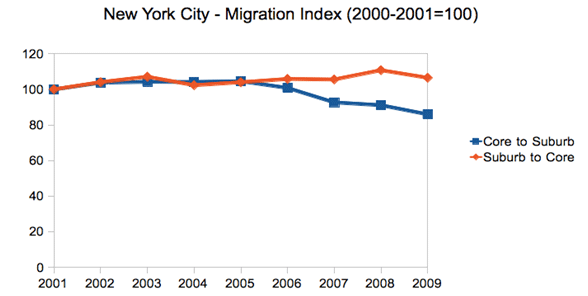
Note: Core defined as the five boroughs of New York City
This chart renders migration as an index, to show changes in in- and out-migration on the same scale. This should not be confused with the total number of people moving, which still shows overall net out-migration, though the trend lines show the same dynamic as above:
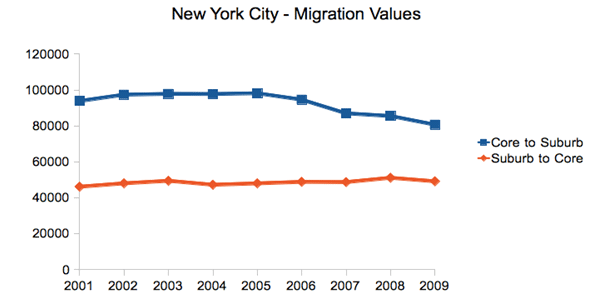
Note: Core defined as the five boroughs of New York City
Philadelphia
Perhaps the most dramatic shift in these four cities was in Philadelphia, where the central city actually gained population for the first time since 1950.
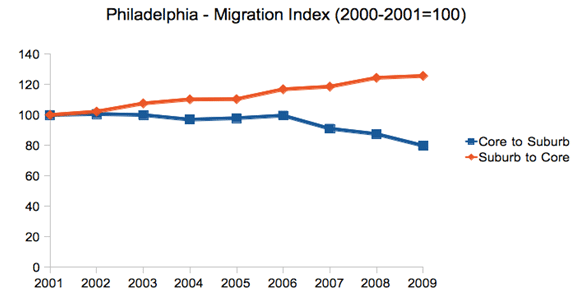
Here are the raw migration numbers, which again show net out-migration, but a distinct shift over the decade.
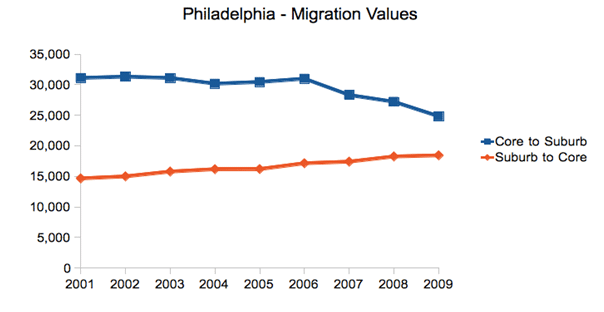
San Francisco
The Bay Area has been divided into two metro areas by the government, San Francisco and San Jose. Therefore, an intra-regional migration analysis looking at San Francisco alone will miss certain migration within the broader Bay Area. With that caveat in mind, we see again the same trend, albeit somewhat less pronounced:
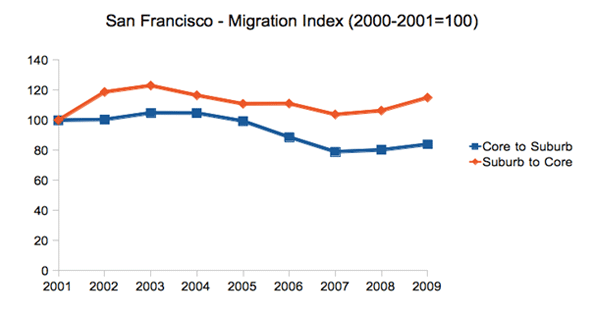
And here are the total migrants:
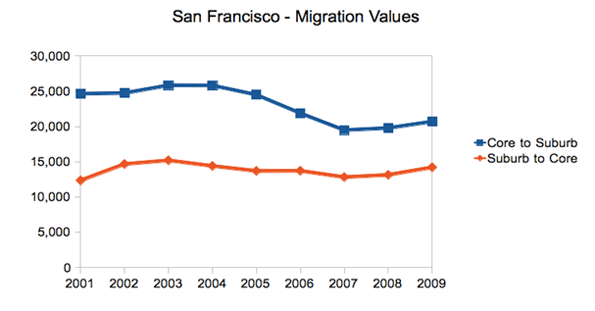
Washington, DC
Due to its very nature as a government town, Washington’s migration patterns differ from the many other cities. However, it has still experienced the same suburbanization phenomenon as the rest of America, and the same changes in intra-regional migration dynamics as the other cities highlighted here, though we see the shift beginning only in mid-decade:
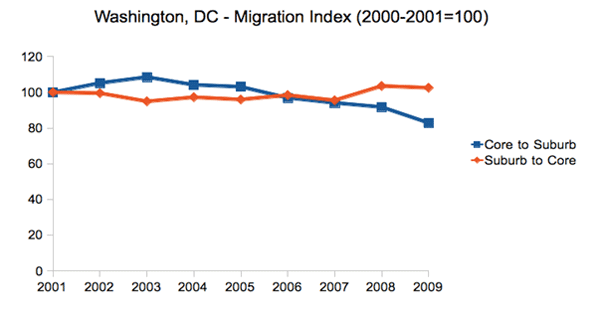
And the raw values:
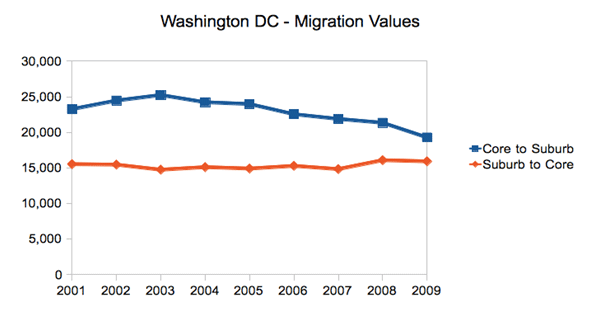
Conclusion
Given the overblown triumphalist rhetoric about the urban core that ultimately hasn’t been backed up by the data, we should be cautious about reading too much into this. Again, net migration remains outward towards the suburbs and away from denser cities to smaller, generally less dense ones (from Chicago to Indianapolis or New York to Raleigh). Overall city population figures were disappointing. And the housing crash and the Great Recession have clearly wreaked havoc with migration patterns on a national level.
Still, these are clearly figures that should inspire some at least small-scale optimism in urban advocates. There has clearly been a shift affecting the net migration in these cities. And the same pattern is visible, though less easily attributable to just the urban core, in a large number of other metros around the country. In particular, the fact the in-migration from the suburbs to the core held steady or even increased is a sign of some urban health.
Back to the city as a mass movement? Not yet. But it’s certainly an improvement. These intra-regional migration statistics are key figures to keep an eye on as we look for any sign of a true inflection point in the overall population trends for America’s urban centers. The whole pattern could also shift again --- in one direction or the other --- as the economy, albeit slowly, comes back to life and people once again get back into the housing market.
Aaron M. Renn is an independent writer on urban affairs based in the Midwest. His writings appear at The Urbanophile, where this piece originally appeared. Telestrian was used to analyze data and to create charts for this piece.
Chicago photo by Storm Crypt / Flickr













hello
I like the way you described the topic with such clarity. This is something I have been thinking about for a long time and you really captured the essence of the subject.
x ray job description
phlebotomy
I have some idea
Pretty good post,hope to see next post
List Detonator V2 review CurationSoft 3.0 Review
This is so cool. I am such a
This is so cool. I am such a huge fan of their work. I really am impressed with how much you have worked to make this website so enjoyable. lesbian strapon strapon
Thanks a lot for sharing
Thanks a lot for sharing this amazing knowledge with us. This site is fantastic. I always find great knowledge from it. lace front wigs half wigs human hair
yeah we can see that over
yeah we can see that over the 2000s out-migration from the core to the suburban counties was relatively flat or even declined late in the decade as general mobility declined in the Great Recession New York, Philadelphia, San Francisco, and . serum korea Kaminomoto In contrast, migration from the suburban counties to the core stayed so what a flat or actually increased, even late in the decade when again overall migration declined nationally are a limited number of cities that have combined city-county definitions that approximate the urban core.
It is vital to protect the
It is vital to protect the remaining European wilderness as it provides ecological benefits: safe haven for endangered species home to undiscovered species; habitats with highly adapted fauna and flora, which would be lost forever if these areas disappeared; refuge for disturbance-sensitive species that may require extensive undisturbed nature for their healthy life; living reference laboratories where the natural process of evolution still continues seo zen review, wp affiliate rocket review, wp rank ninja review, cpa tycoon review, covert viral wizard review
Nice Posting! because there
Nice Posting! because there are a lot of informative postings so, thankskamagra
kamagra oral jellyA
kamagra oral jellyA alallotmentment of innovations in expertise have been made as time
passed by. One of these advancements in expertise is the creation of
mobile phones.
The Internal Revenue Service
The Internal Revenue Service uses tax return data to track movements of people around the country on a county-to-county and state-to-state basis. free cell phone spy software
cell phone spyware
I remember my friend, a
I remember my friend, a financial advisor, helped me to restructure my credit card debts into a simple loan, at a lower interest rate. He has now set up his own website and has a few partners doing financial planning, so you may want to take a look: bad credit debt consolidation.